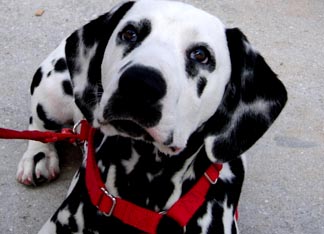
|
When the popular movie "101 Dalmatians" hit the big screen, people became so enamored with the cute pups that, en masse, they went out and purchased one. For many this was a bad choice because they had no idea as to what they were getting themselves into. Dalmatians shed a lot; they're stubborn; they can make otherwise non allergic people very itchy; and because they have a lot of energy and need vigorous exercise, they should be in the suburbs or the country, not cooped up in a city apartment. Dalmatians also require extensive training to avoid serious behavioral problems.
None of this is to imply that Dalmatians are bad. In fact they are loving family companions. But like most dogs, they need a great deal of care and come with a lot of responsibility. Spaying or neutering, regular veterinary checkups, periodic vaccinations, proper diet, exercise and obedience training are just some of the things that need to be attended to for any dog. And of course, dogs need playtime ... and love.
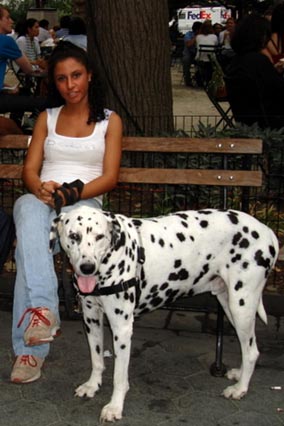
|
Dogs can enrich and improve your life a great deal, but before making the decision to get one, understand that a long term commitment will be required. So it's necessary to consider how the pet will fit into your life. Are you at work a lot? Do you travel often? It's not fair to bring a pet into your life and then have it spend all of its time alone. Will your landlord or condo accept a dog? Do you plan to move? How about the pet policy there? Do you have children? Do they have allergies? Are you prepared for the drooling, shedding or chewing? Do you have a lot of visitors? Can you afford the expense and the time?
Pictured left: Jack and his dog walker were spotted in Madison Square Park. She made no excuses for this particular Dalmatian who has a stubborn and independent streak. Then added: "He's very sweet. It's taken a great deal of consistent training to work with him. If you don't keep up it - he'll easily revert back to his old habits."
Dalmatians, an ancient breed, are born completely white though the beginning of spots can sometimes be visible under the skin of a newborn pup. They are known as the coach dogs originally bred to defend carriages and horses. It's no wonder they may become territorial considering their background. Therefore it's recommend to socialize them, using gentle and positive training. They are a good dog for a family that can appreciate their rambunctious and playful personalities. Dalmatians are good with children in the sense of being somewhat "unbreakable". But due to the dog's strength it is suggested an adult always be present in order to prevent injuries due to innocent play.
These are just some of the questions to ponder before adding this new family member. WOOF Patrol plans to cover these topics and more in detail in future publications. For now, let's consider another decision you will have to make after you've concluded that you are ready for a dog: Which breed?
The 10 Most Popular Breeds (AKC)
1. Labrador retriever
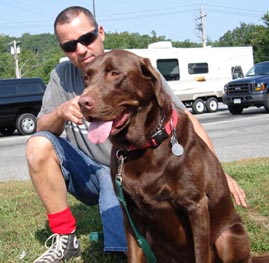
Gene and his lab Elvis
|
Labs are excellent all-around dogs. They're kind, intelligent, and easy to train. They love kids; they're friendly to people and other dogs; and they are always prepared to please their owners.
The height of a Labrador is generally 21-24" and the weight 55-75 lbs. The coat is short, straight and dense with a black, yellow (never say "golden") or chocolate color. The undercoat is soft and weather-resistant.
In the 19th century in Newfoundland, fishermen used Labrador retrievers to fetch fish nets by bringing back the corks that were attached to them.
Brushing a couple of times a week is necessary and vigorous exercise, especially retrieving balls and swimming, is regularly required. Labs are very good service dogs and do well with narcotics detection.
They live 10-12 years.
2. Yorkshire terriers
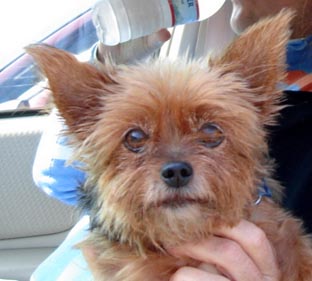
Dodger
|
Yorkies are usually obedient, but they do want to rule the roost. You can count on them to bark if a stranger approaches, but they generally are friendly though capable of intimidating other animals, even large dogs. They are ok with children, but it may be advisable to keep them away from young children. Socializing at an early age is definitely important.
Yorkshire terriers are small, 7-9" in height, and they weigh 3-7 lbs. Their silky, straight and fine coat is steel blue and golden (puppies are black and tan) and long hair on the head is either parted or tied with bows. They require daily brushing and combing.
The Yorkshire terrier was used for ratting in 19th century England. Vigrous exercise is not necessary since they tend to burn up lots of energy running around the house.
Yorkies live 12-14 years.
3. German shepherds
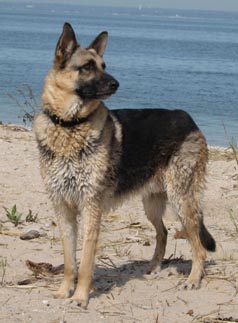
Puppet, owner Lynda Anderson, Founder of Locust Valley Dog
|
Good breeding, socialization and early obedience training will ensure that the German shepherd will be friendly, playful and eager to please the owner. These dogs are highly intelligent and responsive, and because of their ability to focus, easy to train. They are adaptable to city or country living and are very protective of their families. Caution should be taken with strangers as shepherds are not so trusting.
German shepherds are 22-24" in height and weigh 65-95 lbs. Medium-length outer coat is dense, straight and harsh with a color that is usually black and tan or all black. Tails are profuse, slightly bushy, and when carried low, indicate that the dog is relaxed.
In the 19th century, German shepherds originated as sheep herders. Today they are known for their work with police and the military and as seeing-eye dogs. However, because they have been indiscriminately bred, obtaining a shepherd from a reputable breeder is a must since aggressive behavior can be a problem with the poor bred.
Shedding is an issue so daily brushing is necessary. Long walks and lots of playtime will avoid boredom and prevent both medical and behavioral problems.
This breed lives 11-13 years.
4. Golden retriever
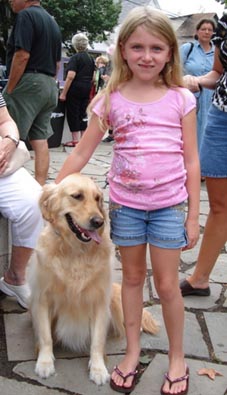
Sandee, Erin's Golden retriever
|
Goldens are very sweet dogs. They're gentle, lovable, affectionate and devoted. They like people and other animals and they love to play with children. However, be prepared to give them a lot of attention. Training can be a bit of a challenge since these dogs easily get distracted. But positive reinforcement usually does the job. When a stranger knocks expect barking though it's generally as a greeting. Country or city living is acceptable provided adequate exercise is available. Keep them fenced in or on a leash because they tend to wander.
Like the Lab, Goldens are 21-24" tall and weigh 55-75 lbs. Color is rich gold with an outer coat that is dense, shiny, wavy or flat, and water-repellant. The undercoat is water-proof.
In the 19th century, the English and Scots bred Newfoundland yellow retrievers with Irish setters, bloodhounds and water spaniels to come up with a dog that would locate and retrieve game.
Golden retrievers shed and therefore need to be brushed and combed regularly. Brisk daily walks, play with other dogs, fetching and swimming are favorite activities. Goldens are very good at narcotics detection and search and rescue. They also make excellent therapy dogs and work well with the physically challenged and the visually impaired.
Life span is 12-14 years.
5. Beagle
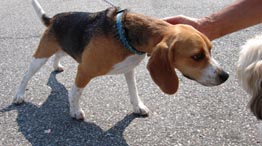
Opie the friendly Beagle
|
Socialization and obedience training are very important for beagles to avoid behavioral problems like digging where they are not supposed to, or excessive barking or howling. But these dogs are friendly; they love people and animals; and
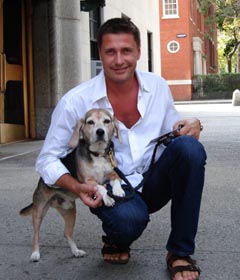
Parker Tate - a Fifth Avenue Beagle
|
they are adaptable to city or country living needing only moderate exercise.
Beagles are 13-15" high and weigh 18-30 lbs. White, tan and black is the typical color combination for this hound that sports a close, hard, medium-length coat.
It's unclear as to when this ancient breed first arrived, but it is believed that they are a result of breeding small hounds from the British Isles with French scent hounds.
Grooming requires the use of a hound glove at least weekly. Beagles enjoy daily walks and running in a secured area.
They live 13-14 years.
6. Dachshunds
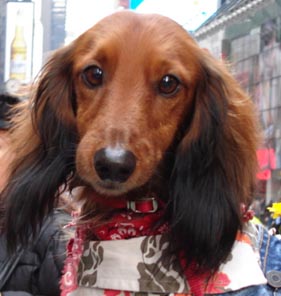
Dachshund Dotti at Times Square NYC
|
Although stubborn, Dachshunds are lively, wise, playful and great family dogs. During training, they tend to get bored but are quick to learn if properly motivated. They are cautious about strangers but interact well with other dogs. They are ideal city dwellers. It is important to be certain that a Dachshund has had good breeding since poor ones can have serious medical and behavioral problems like biting and destructiveness.
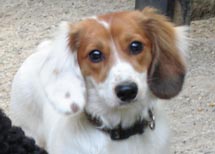
Pie-colored Peanut
|
Dachshunds are 5-7" in height for the miniature and 9-10" for the standard. Weight is 9-11 or 16-32 lbs. There are three types of coats: smooth (short, thick and shiny); wirehaired (tight, short and coarse); and longhaired (soft, sleek and wavy). The coat for all is black, red, brindle, gray, chocolate or fawn unless it's dappled (dark base with lighter highlights).
"Dach" is the German word for badger and "hund" means dog. About 100 years ago, this scrappy dog was bred smaller than the original 35 pound one to hunt rabbits and foxes.
Grooming requirements are as follows: smooth: weekly brushing; longhairs: brushing every day to every other day; wirehairs: brushed and combed twice a week. Dachshunds enjoy walking and ball chasing.
Life span is 10-12 years.
7. Boxer
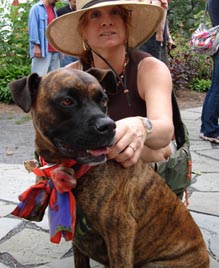
Lucky with mom at the 10th Annual Woodstock, NY Pet Parade
|
Some females can be aggressive and some males are prepared to fight for dominance, but generally boxers are ok with other dogs provided they have early obedience training. This dog is wary of strangers, but with familiar adults and children, it is gentle and fun-loving.
Boxers are 21-25" tall and weigh 55-75 lbs. Their coat is short, straight, shiny and close to the body. Color is fawn (light tan to mahogany), or brindle (black striping). Look for white markings on the muzzle, chest and legs.
Boxers are good police and guard dogs. They were developed in the 19th century for bull-baiting and dog fighting. Only occasional brushing and bathing is required, but considerable exercise and playtime is a must. They also like to jump.
Life span is shorter than many breeds: 8-10 years.
8. Poodle
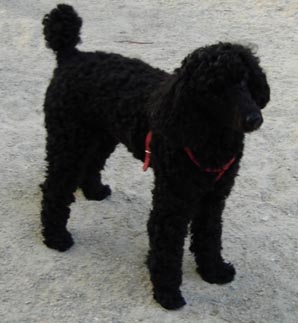
Pia at the Washington Square Park Small Dog Run
|
This is a very bright, very responsive dog that appears in 3 sizes: standard, miniature and toy. Poodles are affectionate, playful and energetic and they get along well with other animals. Miniatures and toys are a bit more cautious with strangers, less tolerate with children and more prone to biting. Poodles are good city dogs because they are not aggressive, even though their bark may make them seem like they are. (Note: the tinier-than- toy "teacup" tends to have temperament and health problems).
Standard poodles are 22-27" in height and weigh 45-70 lbs. Coat color is gray, silver, apricot, black, white, blue-gray, brown or cream. It can be kept curly or corded.
Poodle is derived from the German "pudelin" which means "to splash in the water". The standard poodle was a water retriever in Germany during the Middle-Ages. The coat was clipped in order to reduce water resistance and enhance buoyancy. The standard was also used as a circus dog in France. Miniatures and toys were developed in England during the reign of Queen Anne (18th century) and became truffle hunters, performers, and companions. Poodles are often erroneously called "French poodles".
Though they don't shed, this breed needs to be regularly combed, brushed, clipped and shaped. Every day walks and romps are needed, even more so for standards.
Life span is 10-14 years.
9. Shih Tzu
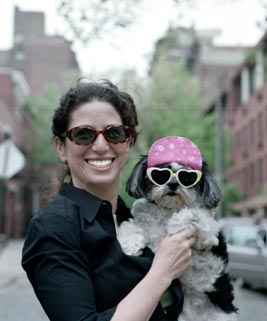
Filmmaker Gayle Kirschenbaum with Chelsea, star of A Dog's Life: A Dogamentary
|
Shih Tzus are happy dogs. They are outgoing and affectionate and they are great with children, people and other animals. This breed is very adaptable to city, country, or suburban living. They love to play and should be walked regularly.
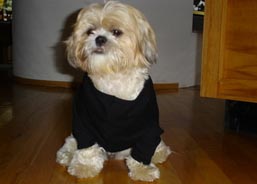
Pomo, WOOF Patrol's mascot
|
The height of a Shih Tzu is 8-11" and they weigh 9-16 lbs. The most common colors are black and white, gray and white, or tan and white. With a show coat, which extends to the ground, though there is no shedding, they must be brushed and combed very often to avoid severe matting. Even the more popular "puppy cut" requires daily brushing. Eyes and ears should be cleaned daily to prevent infection.
This breed has a long history that extends back to Imperial China where they were valued companions. Their image has appeared on Chinese carvings, embroideries and other objects for centuries.
Life span is 12-14 years.
10. Miniature Schnauzer
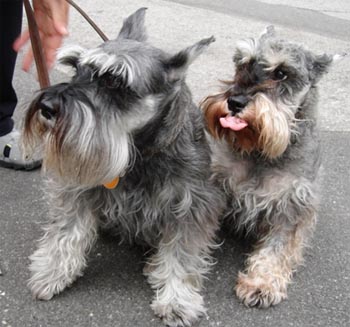
Caroline and Emma canine strolling through Washington Square
|
Early socialization and obedience training will ensure that miniature Schnauzers will be good family dogs and friendly with other animals. Some Schnauzers can be barkers and reserved with strangers. This dog needs long walks.
The height of this breed is 12-14" and the weight 14-15 lbs. The salt and pepper, black and silver, or solid black coat is hard and wiry. Schnauzers should be brushed and combed a few times a week and the beard needs daily cleaning. Regular trimming is required.
Named after the German word for nose or muzzle, the Schnauzer's bloodlines extend from the affenpinscher, giant Schnauzer and miniature pinscher from the 19th century. They were known for ratting.
These good watchdogs live 12-14 years.
WOOF Patrol's paw-observation:
We wanted to discover if it was possible to capture the photographs of the top ten breeds in a matter of a day. The clear answer: yes. The biggest surprise to us was the popularity of the #5 category: Beagle. Beagles were everywhere - on the streets, in the parks, taking a pit stop on the interstate rest areas and elsewhere. We never imagined the breeds' proliferation. Owners of the howlers and the non-howlers tell us they are sweet and very friendly. The other surprise was to learn that Boxers, besides being known for their fawn coloring, can also be a chic brindle shade. |
Other "New Dog" Thoughts:
- Puppies require dedicated care comparable to a newborn's need. Training is recommended for first time owners to gain a better understanding of puppy development with issues such as, socialization, behavior and obedience.
- Adopting an adult dog is a great idea. Shelters and rescue groups are the best sources for dogs needing homes. However, an adult dog comes with its own set of considerations like behavioral therapy or retraining to weed out undesirable habits or improve upon canine etiquette. These should be factored into your dog decision. If a dog is being brought into a household with young children, make sure the dog is not aggressive or doesn't display territorial issues.
- Large dogs require more of everything like food, space and exercise. Cost of things such as boarding and hospitalization are higher with a larger breed. The amount of waste from a large dog is greater. And they may be too heavy to carry. Traveling is easier with small dogs because they can fit inside a small carrier underneath a plane seat, instead of being transported in the cargo area. Dog-friendly hotels very often have canine weight restriction policies that limit the weight to 25 pounds or less.
- Male dogs tend to want to roam and may even show more aggressive play. They also mark their territory which may be detrimental to your garden and furniture.
- If a female is not spayed before her first heat, she may develop tumors in mid-life. Females tend to take themselves seriously while males have a better sense of humor.
|